With the Medinilla you bring an extraordinary plant into your home. Even if keeping them is not easy, we will explain how to optimally care for the Medinilla and promote its flowering.

The tropical plant Medinilla magnifica has a particularly long flowering period, during which it extensively displays its decorative flowers. Here you can find out how to get the Medinilla to flower and what the most common care mistakes and diseases are.
contents
- Medinilla: origin and characteristics
- The most beautiful types and varieties
- Planting Medinilla: location, soil and procedure
-
Care of the Medinilla
- Pruning, watering and fertilizing
- Medinilla withering: care after flowering
- Save Medinilla: what to do in case of leaf loss and diseases?
- Propagating Medinilla
- wintering
- Is the Medinilla poisonous?
Medinilla: origin and characteristics
The Medinilla (Medinilla magnifica), also called Medinille, Kapa-Kapa or Malaysian orchid, originally comes from the Philippines and belongs to the black-mouthed family (Melastomataceae). The evergreen shrub grows in its tropical home both epiphytic (on trees) and terrestrial (on the ground). Because of its magnificent flowers, the Medinilla is also becoming increasingly popular as a houseplant. It can reach heights of 2.5 meters in nature and the Medinilla can also grow up to 1.5 meters in the apartment - although it usually keeps smaller dimensions.
The Medinilla has leathery, dark green leaves with a pronounced veining and produces pink, raceme-shaped flowers between February and August. These hang down from the light green flower stalks and can grow up to 30 cm long. After fertilization, the small flowers are replaced by berries, which contain the seeds and are also very decorative.
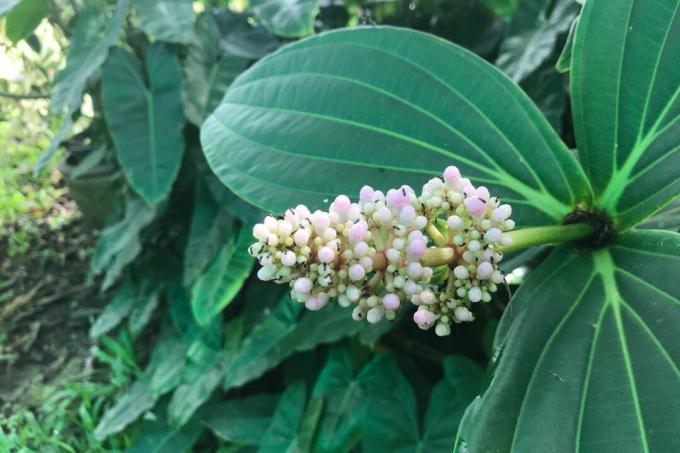
The most beautiful types and varieties
In addition to the Kapa-Kapa, there are many other Medinilla species, but these are hardly available as houseplants. Consequently, therefore mostly the Medinilla magnifica meant when talking about the Medinilla. However, there are still numerous varieties of this species, some of which we present here.
- Medinilla magnifica 'Flamenco': This Medinilla strain has bright pink flowers and stems, which gives it its name.
- Medinilla magnifica ‘Piccolini’: The 'Piccolini' variety is smaller than the actual Medinilla, but has equally beautiful leaves and flowers.
- Medinilla magnifica ‘Dolce Vita’: The flowers of the 'Dolce Vita' variety are even more magnificent, with a larger number of individual flowers and a longer panicle.
- Medinilla magnifica ‘Lambada’: The Medinilla 'Lambada' variety has a similar color to the 'Flamenco' variety, but is slightly smaller.
- Medinilla sortechinii: This is another species of Medinilla that has orange-red, coral-like flowers and is unfortunately only very rarely commercially available.
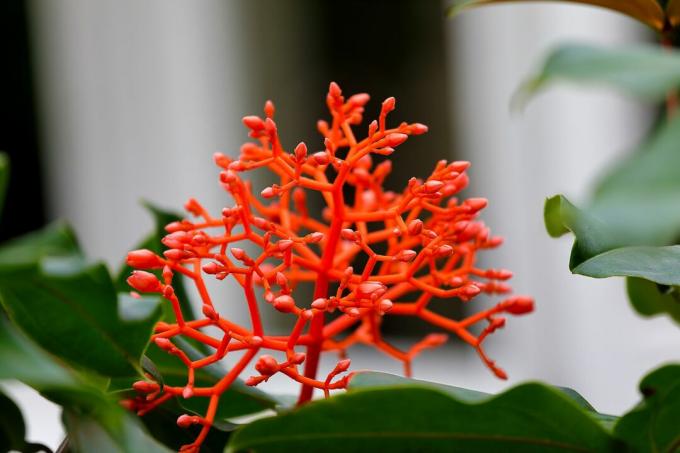
Planting Medinilla: location, soil and procedure
The Medinilla is a plant from the tropics, which accordingly requires warmth and high humidity. A suitable location for the Medinilla is also bright, but not exposed to direct sun. If you own a conservatory, it is best to place the Medinilla there. Since it grows in tropical forests, it is best kept in light shade, for example under a taller plant.
The temperature should be between 19 and 25 °C, in winter it can be a little cooler. In the cold season, the Medinilla needs a resting phase in which the flower buds are created for spring. Even in winter, however, temperatures must not fall below 15 °C. The humidity should be at least 60% all year round and can be increased by spraying the plant or by placing water bowls.
Drafts damage the Medinilla just as much as strong temperature fluctuations or frequent moving of the plant - so avoid this as far as possible.
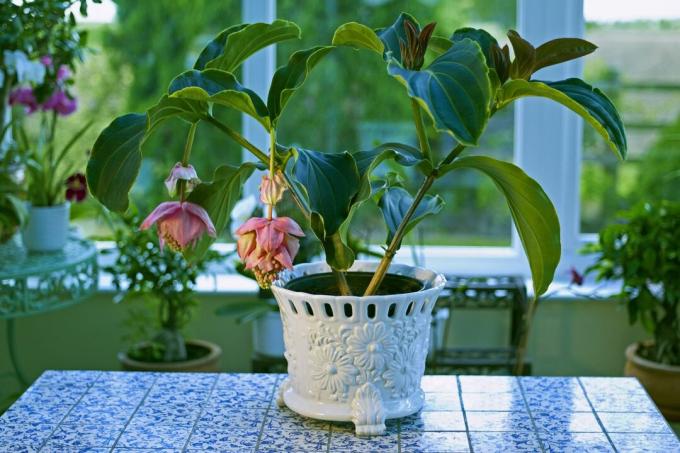
tip: You can also place the Medinilla on a trivet filled with pebbles or expanded clay and water. The plant is not directly in the water, but still benefits from the rising damp.
The substrate for the Medinilla must be permeable, humic and slightly acidic. It makes sense to put a layer of pebbles or potsherds on the bottom of the pot so that excess water can safely drain away. Our peat-free, for example, is a suitable substrate Plantura organic potting soil. With its slightly acidic pH, our soil offers optimal conditions for the Medinilla. Their resource-saving production also makes the earth an environmentally friendly choice.
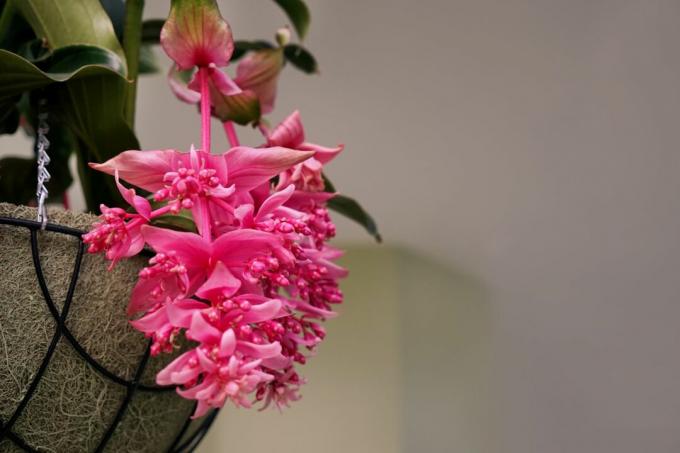
Care of the Medinilla
Since the Medinilla is a plant native to the tropics, caring for it can be a bit of a challenge. The choice of location is particularly important. If the Medinilla feels comfortable in its place, nothing stands in the way of a rich bloom. When caring for the Medinilla, pay particular attention to sufficient water and nutrients during the flowering period and to the rest period in winter.
Pruning, watering and fertilizing
The root ball of the Medinilla should always be kept moist during the growing season. The water must be able to drain off well and should be removed from the saucer or planter about 15 minutes after watering. In summer you can also completely submerge the root ball in water from time to time and then let it drain well. Always use room-warm and lime-free water, also for spraying the leaves. Watering should be reduced in winter: during the dormant phase, only water enough to prevent the root ball from drying out.

Since the flowering period of the Medinilla lasts several months, the plant needs sufficient nutrients. Fertilize once a week during the growing season from February to August to support growth and flowering. As a biological fertilizer, for example, offers our Plantura organic flower & balcony fertilizer at. This high-quality liquid fertilizer can be easily administered via the irrigation water and provides the Medinilla with important nutrients. The purely organic fertilizer consists of natural ingredients and protects the environment. During the dormant phase in winter, the Medinilla does not need any fertilizer.
While it is possible to prune the Medinilla, it is not necessary. By cutting off dried flowers, the flowering period can be extended. Dead and withered leaves can also be removed. If you prune the Medinilla shoots by half their length after flowering, you ensure more flowering potential next year. It is also a good idea to cut back the Medinilla more generously in spring - down to the woody shoots. This promotes new growth and stimulates branching.
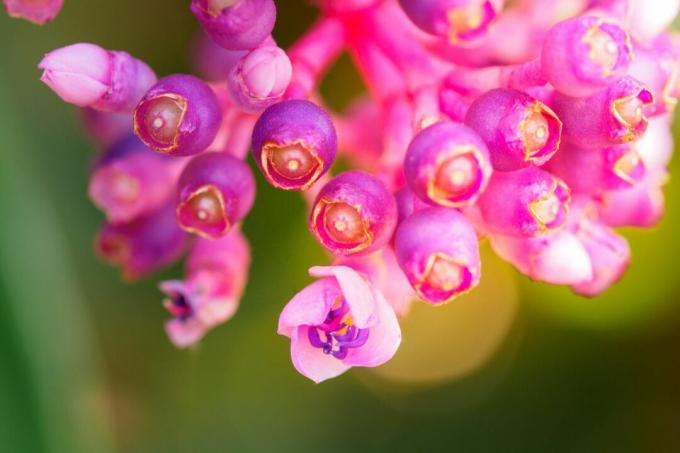
Repotting takes place before flowering in spring when the old pot has become too small. Since the roots of the Medinilla are very sensitive, care should be taken when repotting: damage or division of the root ball can lead to leaf loss, among other things.
Medinilla withering: care after flowering
As soon as the flowers of the Medinilla magnifica faded, you can cut them off. At the end of the flowering period, some new leaves will appear. From this point on, the Medinilla should be hibernated at temperatures of 15 to 20 °C. Avoid fertilizer and reduce watering to stimulate bud formation. Cool temperatures are beneficial, but it should not be colder than 15 °C. Once buds have developed, the Medinilla can again be kept in a constant location in warmer conditions.
Save Medinilla: what to do in case of leaf loss and diseases?
The Medinilla care is not very easy, which is why it can often lead to damage. We clarify the common causes of leaf loss and discoloration and how you can save your Medinilla.
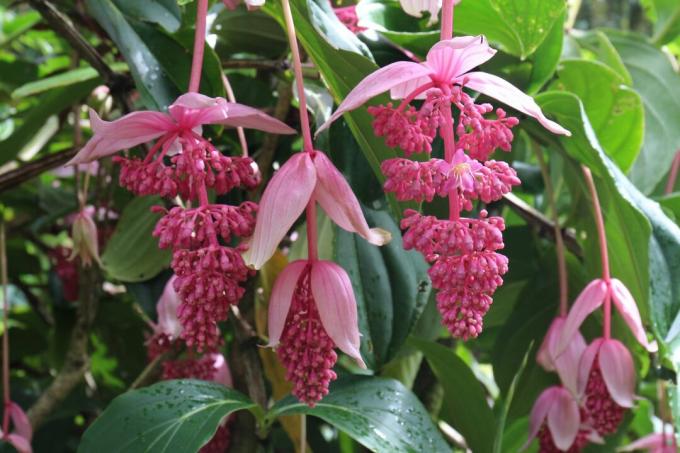
- leaves fall off: Causes of leaf fall can be draughts, insufficient light and low humidity. Switching to a new place also leads to loss of leaves.
- Leaves turn brown: Brown foliage is often the result of waterlogging or dry air. Check the substrate and repot the plant in fresh soil if necessary. The pot must have a drainage hole to drain excess water.
- spider mites: If the air is not humid enough, it can easily lead to infestation spider mites come. This manifests itself in webs and small spots on the leaves.
- Scale insects/meal lice: scale insects and Mealybug can be recognized, among other things, by the honeydew they secrete. They weaken the plant by sucking out its sap. Against the uninvited guests, for example, our Plantura Organic Pest Free Neem are used, which the lice absorb via the plant sap.
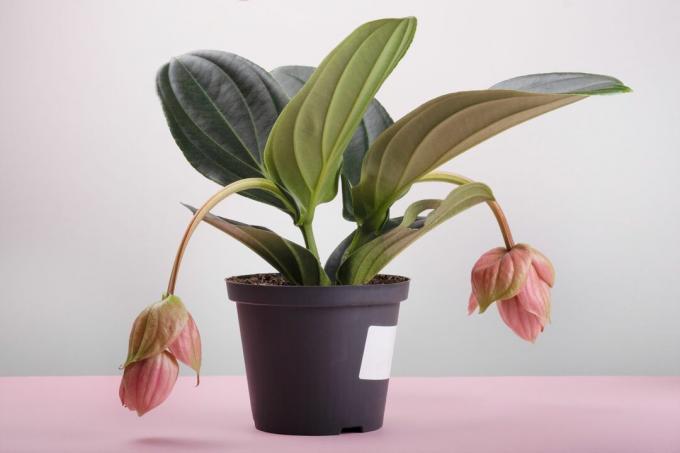
Propagating Medinilla
Propagating the Medinilla is not always successful, because its cuttings require special conditions. Since the plant tolerates pruning well, there is nothing wrong with trying it.
To do this, after the flowering period in autumn or spring, cut about 10 cm long cuttings from the non-woody shoots at an angle with a sharp knife. Apply rooting powder, which is available in garden supplies and stimulates root formation with special plant hormones, to the cuts of the cuttings. Now the cuttings must be placed in a suitable substrate, such as sphagnum moss, and kept under warm, humid conditions. The temperature in the root area should be constant between 30 and 35 °C; this can be achieved with a heating mat. In addition, a high level of humidity must be ensured, which you can achieve, for example, by putting a plastic bag over it. After about four weeks the first roots have formed.
Tip: Willow water can also support rooting, as willows naturally contain a large amount of the plant hormone auxin. To do this, you put young willow shoots in water, which then release the hormone into the water.

You can Medinilla magnifica also grown from seed by sowing them on moist sphagnum moss. The Medinilla can also be propagated by removing moss, preferably on the bracts between March and April.
wintering
During the winter months, the Medinilla is allowed a rest period of eight to twelve weeks, during which time the buds are laid for flowering in the spring. It should be around 15 to 17 °C cool, but never colder than 15 °C. Reduce the watering so much that the root ball just does not dry out. Unlike in summer, it does not have to be kept moist all the time. When the substrate is dry on the surface, you can water a little again. Fertilizers are not applied at all during this time.
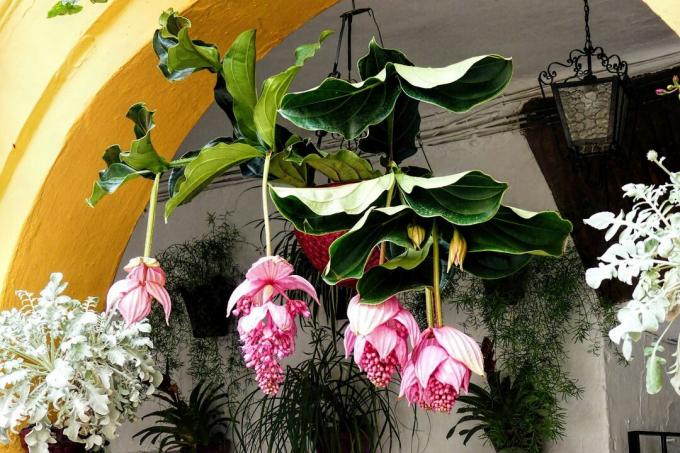
Is the Medinilla poisonous?
Whether the Medinilla is poisonous has not yet been finally clarified. It is assumed that it does not contain any toxic substances, but there is no certainty. To be on the safe side, no parts of the ornamental plant should be eaten.
the Medinilla magnifica is not the only houseplant that flowers continuously. We'll introduce you to a few more flowering houseplants in front.



